
FORD Fiesta 3 Doors
Generations Timeline, Specs and Pictures

The Fiesta started its story with a 3-door version, back in the 70s.
Eventually, it gained another pair of doors to ease access to the rear seats. In time, from the no-AC vehicle, it grew and became a stylish car. In 2017, the new Fiesta 3-door was launched at a special event and brought some novelties for the small Ford vehicle.
For the 3-door version, Ford introduced the Ford Fiesta Vignale model - part of the Ford Vignale upscale product and ownership experience. The Fiesta Vignale joins the Mondeo, S-MAX, Kuga and Edge Vignale models as the highest expression of the Ford brand in Europe, and offers unique 18-inch alloys wheel designs, exclusive exterior detailing and colors, and hexagonal-quilted, tuxedo-stitched leather seats. It also featured a premium B&O PLAY Sound System, and for the first time offers an openable panoramic glass roof. The Fiesta’s sophisticated SYNC 3 communications and entertainment system with touchscreens up to 8-inches.
The ST-Line is offered for those who are looking for a sportier version. models that deliver exterior and interior styling inspired by Ford Performance models alongside Ford EcoBoost gasoline and diesel engines.
The 3-door Fiesta featured a range of technologies that enhanced comfort, convenience, and safety. The Fiesta was the first Ford to deliver an enhanced version of Pre-Collision Assist with Pedestrian Detection. A wider camera angle helps to better track pedestrian movements.
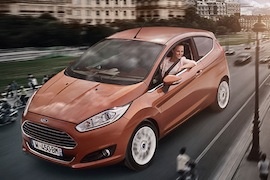
The facelifted version of the sixth generation of the Ford Fiesta was launched in 2014.
It was a breath of fresh air for both versions with three and five doors of the small Ford Vehicle in Europe.
The revised version featured a new design, new in-car entertainment, and new engines. Since its introduction on the market in 1976, the Fiesta was well received by the market and it grew in size and improved the comfort and the amenities. It’s been offered as a three and five-door hatchback versions and it was available with both economic or sporty engine configurations. Since its launch until 2013, the Fiesta was sold in more than 15 million units around the world.
The 2013 model had a different front bumper and a bigger, wider, with new design grille. It was the first Fiesta with the new, Focus-style, grille. For the ST-Line trim level, the car received a sporty suspension with lower ground clearance, a new lip spoiler, a diffuser in the back, and a roof spoiler.
Inside, the 2013 Fiesta has received a new, SYNC 3, infotainment system. It was also fitted with the MyKey system, which allowed parents to limit the speed and volume. It also muted the stereo until the seatbelts were fastened.
For the engine bay, the Fiesta 3-doors was available with either a 3-cylinder 1.0-liter EcoBoost engine or a 1.5-liter turbodiesel. For those who want more fun at the wheel, there was the Fiesta ST.
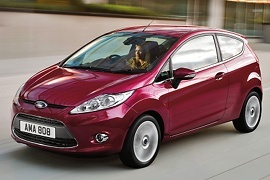
The sixth-generation Ford Fiesta revealed in 2007 at the Frankfurt Motor Show featured Ford’s kinetic design philosophy introduced in 2006.
Compared to the previous generation Fiesta, the exterior design was a huge change, expressing agility and attitude. The agile look was given by the big grille on the lower part of the bumper that incorporated the license plate bracket. The sweeping roofline ended into a small spoiler, while the very angled A-pillar added to the dynamic look.
Both the 3-door and the 5-door versions were based on the same body, thus the 5-door didn’t feature a less sporty or dynamic design.
Built on Ford’s new global B-car platform, the new Fiesta featured a simple suspension layout with McPherson struts on the front and semi-independent rear suspension.
Compared to the 3-door Fiesta, the Fiesta 5-doors models came with a bigger glass area that created a roomier feel inside the cabin.
Inside, the Fiesta 5-doors featured a roomy cabin for the front occupants, however, the rear passengers struggled with limited legroom and headroom.
The interior was pretty modern for 2008, and depending on the trim level, it featured automatic climate control, heated power side mirrors and an automatic gearbox.
Both gasoline and turbo-diesel engines were available and could be paired with a 5-speed or a 6-speed standard manual transmission depending on the powerplant fitted.

Ford upgraded the fifth generation of the Fiesta in 2005 to improve the small car image on the market, and the results were better than expected.
The sporty, 3-door version was the base model for the sporty hot-hatch Fiesta ST, which was in its first generation. Ford tried, and succeeded, to build a desirable car among the younger generation, and with the new 2005 updates, it made it safer.
From the outside, Ford’s designers didn’t seem to work too hard. At the front, it featured better headlights with clear lenses and a slightly reshaped grille. Depending on the trim level, a set of round fog-lights, or angular ones, found their way at the lower side of the front bumper. In the base level, there wasn’t any.
Inside, Ford improved the car’s dashboard and changed some materials to make the car more pleasant for the passengers. The base trim level featured black plastic everywhere on the dashboard and door panels, with no tachometer inside the instrument cluster. The upper trim level received sport-bucket seats, two-tone fabric upholstery, and better finishes. Its CD-stereo was improved for better sound and even voice-control. An unusual feature for its class was the optional automatic climate control.
Ford already updated the technical part of the car to the Euro 4 requirements, but it tried to go past that and included the ESP on the list to make the car safer on the road. Under the hood, the carmaker installed a choice of five gasoline and two diesel engines.

In 2004, Ford introduced the sixth generation of its small-class vehicle, the Fiesta.
It was aimed at a market thirsty for urban cars and filled with French and Italian brands.
The Fiesta was already an established and successful name on the market, but the fifth generation was no longer a match against the Clio, the 206, or the Punto. But the 2003 Fiesta was a great answer.
The designers were asked to build a roomy interior inside a small-sized vehicle. The most logical answer was a boxy-looking car. But they were able to imagine a front fascia with sloped headlights and a small grille between them. The three-door version featured longer front doors, and the side windows were shorter in the back than at the front, creating a dynamic image. On top of the tailgate, a small roof-spoiler was available for selected versions. Its taillights were mounted high on the C-pillars to protect them against small bumps in the parking lot.
Due to the boxy exterior, the interior was roomy for four adult passengers. There was little room in the back for three occupants, but it was enough for short, in-city trips. The Fiesta didn’t offer power mirrors for the base levels, but the AC was fitted as standard for most of the range. The floor-mounted gearstick was part of the center console. On the center stack, a radio-cassette player was standard as well. A CD-player was on the options list.
Under the hood, the Fiesta 3-doors was fitted with a 1.2-liter gasoline engine, while the top version was the Fiesta ST with its 2.0-liter and 150 hp. The diesel versions were developed with Peugeot-Citroen, resulting in two versions that produced 68 hp or 90 hp.
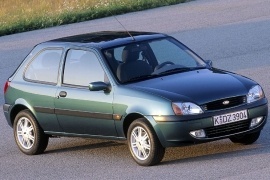
Ford introduced the fourth generation of the Fiesta in 1995 and refreshed-it in 1999.
Although it wasn’t a completely new car, it featured a totally different face.
Ford tried and gained with the New-Edge design language used for the first generation of the Focus and the sporty Puma. The idea was to combine long and curved lines in sharp angles. The compact-sized vehicle was such a success that the blue-oval management decided to apply the same theme on the smaller Fiesta.
From the oval-shaped headlights to the triangular ones, it was a complicated design process that imposed new fenders, hoods, and grille. The rear panel, quarter panels, and the tailgate were redesigned to accommodate a new set of taillights designed in the same trend in the back. The three-door version looked sportier, but Ford didn’t fit it with engines adequated for its look.
The interior was still part of the biodesign era, with rounded shapes and a curved dashboard. But Ford changed here and there a few buttons and the audio system. For the Ghia trim level, the designers installed a wood-trim, which might have looked better on a larger car than in a small-segment vehicle. The interior room was good for a family of four with adequate legroom in the back.
For the 1999 Fiesta, Ford dropped the 1.1-liter engine and made the 1.3-liter unit the base version. A new, 1.25-liter ZETEC engine was installed and offered 75 hp. For selected markets, the Fiesta featured a 1.6-liter engine. Since there was already a higher demand for the diesel versions, Ford installed an improved 1.8-liter unit.
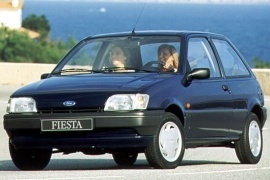
Between 1996 and 1998 this car would top the sales in Britain.
Though it was essentially a third generation car underneath, the 1994 model was branded as the fourth generation of the Fiesta. The modifications included a new dashboard design on the passenger side and new suspension system that made the Fiesta the best handling in its class. The engine line-up was refreshed with Zetec models and new trim levels. The car was made available in Argentina and Chile but was no longer sold in the US.
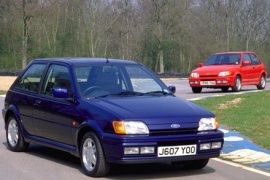
The three-door Fiesta was the original version, and that was kept for the third generation of the supermini-segment Ford contender.
While Europe was shaking off the communist regimes, Ford celebrated with a new generation of the Fiesta. It was drastically improved from top to bottom and from the hood to the tailgate. But Ford had a different problem now: should it address the car to its regular customers or risk and find new ones to introduce some more expensive versions. In the end, it chose to stay true to its clients and expand the lineup a little more with the introduction of a five-door Fiesta and a light-utility vehicle named Courier.
There were still some cues that resembled its predecessor, but the overall design was far more different than that. The angular, horizontal headlights featured corner-mounted turn-signals, even though Fiesta featured additional turn signals on the front fenders. With its black handles on the doors, the car offered better access inside than most of the vehicles built in the East-European countries.
Inside, a new design trend broke the past’s angular lines and brought the new, smoother lines of the ’90s. It was the dawn of the biodesign era. The center-mounted speedometer and the race-inspired look for the tachometer were a good sign of evolution for the small-segment Ford car. The Fiesta was offered with a sunroof, radio-cassette player, air-conditioning, and power-windows on the options list. For the most powerful version, the XR2i, the Fiesta offered sport-bucket seats that matched the car’s handling.
Ford promised to offer fuel-efficient engines and installed a choice of gasoline and diesel units. All of them were paired to a 5-speed manual transmission.
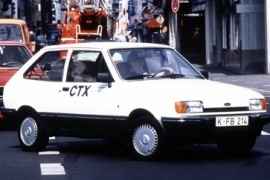
In 1986 Ford introduced a facelifted version for its small-segment contender, the Fiesta, which was already at its second generation.
With an increasing demand for small, fuel-efficient vehicles, Ford tried to get a bigger market slice and improved the small Fiesta. It was an excellent city vehicle, and thanks to its improved engines and transmissions, it started to be more appealing than its main rival, the Volkswagen Polo.
To mark the updated version, Ford’s designers changed the bumpers, and that was mostly about it. The car was offered only as a 3-door vehicle, with black door-handles and black, unpainted door-mirrors. The wedge-shaped bodywork went through a small update with rounded edges on the hood’s front side. Depending on the trim level and engine version, it sported steel or light-alloy-wheels.
Inside, Ford started to grow a center console, while on the non-facelifted version, there was none, only the gear-stick popping up from the car’s floor. The carmaker noticed that the customers were not satisfied with the material’s quality and offered new interior trims and new upholstery for seats and rear folding bench.
Under the hood, Ford introduced new engines, including a lean-option version for the 1.3-liter unit to compete against the new diesel-powered French cars. From 1987, Ford introduced a continuously variable transmission (CVT) gearbox for the 1.1-liter engine, providing more comfort for heavy traffic.

Ford launched the second generation of the Fiesta in August 1983, and it wasn’t that much different than its predecessor.
With an increased demand for small-sized vehicles, the Fiesta MKII was no longer alone in the segment. Meanwhile, Volkswagen introduced the second generation of the Polo, and Opel introduced the Corsa. The French carmakers were already there with the Renault 4 and the Citroen Visa. Ford had to improve the Fiesta and keep its momentum as one of the best selling vehicles in its class.
With a revised front end that started to be rounded a bit and a tailgate that didn’t look like a flat, sloped plank in the back, the Fiesta convinced more customers that it deserved a spot on the sales podium. Its front turn-signals were moved from underneath the headlights to the sides and became more visible when the driver changed lanes. Another way to improve safety was the introduction of a door mirror on the passenger side. Like its main German rivals, it was available only in three-door form.
Inside, the carmaker designers adopted a new design language and made a squared-looking instrument cluster extended over the center stack. In those times, Ford did not consider the center console a must for a small-sized car. Maybe because sometimes you had to cross the vehicle from one side to another if a door refused to open. Like its predecessor, the Fiesta MKII kept the folding seatback for the bench to extend the trunk area, which was not so generous.
Under the hood, Ford introduced new engine choices, including a naturally aspirated diesel version that was highly fuel-efficient.
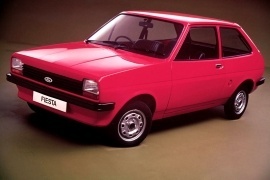
The Fiesta project started in 1972 when Henry Ford II approved a small-sized, front-wheel-drive vehicle built as a world car to be sold globally.
Ford’s engineers noticed the ascending trend of front-wheel-drive vehicles on the market. Moreover, the carmaker already produced the Taunus in Europe since 1960 with that architecture, and it was very successful for small cars. But the Fiesta was smaller and perfect for receiving that engine-transmission configuration.
The blue-oval brand tried to build the Fiesta as an affordable vehicle, but without being bland. Its small, rectangular headlights with separated turn signals underneath them were a new trend for the carmaker. A black plastic grille with horizontal slats was spread between them, above the metallic bumper. Behind it, a longer apron continued the front fascia. From its sides, the slightly arched ascending beltline formed a specific design cue for the little vehicle. In the back, the Fiesta featured a wide-open tailgate between the narrow, vertically mounted taillights.
Inside, it was just as simple as on the outside, with a flat dashboard that sported an open storage area in front of the passenger. The instrument cluster featured two round dials for the speedometer and tachometer and a smaller one for the fuel level. It’s flat front seats were good as a daily commuter, but nothing special. In the back, surprisingly, the car offered room enough for two adults.
Under the hood, Ford installed a choice of four engines ranging between 45 hp and 83 hp. The XR2 version used the latter.























































